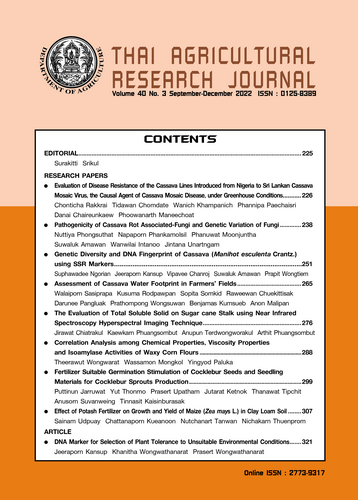Assessment of Cassava Water Footprint in Farmers’ Fields
DOI:
https://doi.org/10.14456/thaidoa-agres.2022.22Keywords:
water footprint, cassava, water managementAbstract
Water footprint is used as a tool to measure both direct and indirect water uses by crops or products. Cassava fresh root yield has a wide range of uses in many local downstream industries. Water footprint (WF) of cassava had mostly been reported from secondary data- due to limited availability of field-based publication. WF of cassava fresh root yield in farmer's fields was investigated from 4 consecutive growing seasons from 2017/18 to 2020/21 in 26 provinces. Results showed that WF varies for each region due to differences in soils, weather and management. Most cassava were grown under rainfed conditions and KU50, R5 R72 and R11 were the major cultivars. The growing season started from March to May, earlier in eastern region and later in the northern region, thus varied from 10.4 to 19 months long. The average fertilizer application rate was 7.2 kg.N/rai The average yield was 4.1 ton/rai. Average yield from Udon Thani province was the highest at 6.5 ton/rai and Pitsanulok was the lowest at 2.9 ton/rai. The WF assessment showed that water uses per 1 ton of fresh root product was 268 m3 whereas 226 m3 is WFgreen and 42 m3 is WPgrey. Uthai Thani province was the highest at 402 m3 and Udon Thani was the lowest at 138 m3. The water footprint was found to be positively correlated with the amount of fertilizer used but was the opposite for cassava fresh root yield. The month of the year at harvest, number of months after planting and planting year tend to increase water footprint, whereas cultivar was not found to be related to water footprint.
References
ชัยวัฒน์ โซวเจริญสุข. 2563. แนวโน้มธุรกิจ/อุตสาหกรรม 2563-2565 : มันสำปะหลัง. แหล่งข้อมูล : https://www.krungsri.com/th/research/industry/industry-outlook/agriculture/cassava/IO/io-cassava-20. สืบค้น : 2 กุมภาพันธ์ 2565.
ชินาธิปกรณ์ พงศ์ภิญโญภาพ และ ธำรงรัตน์ มุ่งเจริญ. 2554. วอเตอร์ฟุตพริ้นท์ของกระบวนการผลิตเอทานอลจากมันสำปะหลังในประเทศไทย. วิศวกรรมสาร มก. 24(75): 41-52.
ทิพยปภา สุขุมาลชาติ อดิชัย พรพรมหมินทร์ และสุรชัย ลิปิวัฒนาการ. 2556. วอเตอรฟุตปริ้นของข้าวโพดเลี้ยงสัตว์ในประเทศไทย. วิศวกรรมสาร มข. 40(1): 67-78
นพศูล สมุทรทอง เอ็จ สโรบล วิจารณ์ วิชชุกิจ และสุเทพ ทองแพ. 2550. ผลของปริมาณและอัตราการให้น้ำต่อการเจริญเติบโตและการให้ผลผลิตของมันสําปะหลัง. หน้า 75-82. ใน : เรื่องเต็มการประชุมทางวิชาการของมหาวิทยาลัยเกษตรศาสตร์ ครั้งที่ 45 สาขาพืช. กรุงเทพ.
บัญชา ขวัญยืน ปริวัตร น้ำค้าง วัลลภ ภู่ทองสุข และ ศุภกิจ ตันวิบูลย์ศักดิ์. 2553. การศึกษาหาสัมประสิทธิ์การใช้น้ำของมันสำปะหลัง. หมาวิทยาลัยเกษตรศาสตร์ วิทยาเขตกำแพงแสน นครปฐม. หน้า 274-281. ใน: การประชุมวิชาการนานาชาติสมาคมวิศวกรรมเกษตรแห่งประเทศไทย ครั้งที่ 11. นครปฐม.
ประภาศรี จงประดิษฐ์นันท์ ประพิศ แสงทอง จิรพงษ์ ประสิทธิเขตร สุรสิทธิ์ อรรถจารุสิทธิ์ ศุภกาญจน์ ล้วนมณี ละแย้ม เกื้อหนุน สรัตนา เสนาะ วนิดา โนบรรเทา ลาวัณย์ จันทร์อัมพร พัชรินทร์ นามวงษ์ และอนุสรณ์ เทียนศิริฤกษ์. 2548. วัสดุอินทรีย์และปุ๋ยคอกในพื้นที่ทำการเกษตร. ชุมนุมสหกรณ์การเกษตรแห่งประเทศไทย, กรุงเทพ. 216 หน้า.
วลัยพร ศะศิประภา จิณณจาร์ หาญเศรษฐสุข กุสุมา รอดแผ้วพาล ปฐมพงษ์ วงศ์สุวรรณ์ ดรุณี เพ็งฤกษ์ เสาวรี บำรุง วารีย์ เวรวรณ์ สายน้ำ อุดพ้วย และอนุสรณ์ เทียนศิริฤกษ์. 2561. การวิเคราะห์วอเตอร์ฟุตพริ้นท์ของมันสำปะหลังที่มีการจัดการน้ำแตกต่างกัน. ว.วิชาการเกษตร. 36(2): 173–185.
สานิตย์ดา เตียวต๋อย ชลิตา สุวรรณ และธณัฏฐ์ยศ สมใจ. 2555. วอเตอร์ฟุตพรินต์ของอ้อยและมันสําปะหลังสําหรับการผลิตเอทานอลในภาคตะวันออก ประเทศไทย. ว. สมาคมวิศวกรรมเกษตรแห่งประเทศไทย. 18(1): 68–75.
สำนักงานเศรษฐกิจการเกษตร. 2560. มันสำปะหลังโรงงาน. แหล่งข้อมูล : https://www.oae.go.th/assets/portals/1/files/production/fieldcrop/casava/2-59.pdf. สืบค้น : 4 กุมภาพันธ์ 2560.
อนัตยา บุญฮวด นาฎสุดา ภูมิจํานงค์ และอัจฉรา อัศวรุจิกุลชัย. 2557. การประเมินวอเตอร์ฟุตพริ้นท์ของการผลิตเอทานอลจากมันสําปะหลังพื้นที่จังหวัดลพบุรี ประเทศไทย. หน้า 392-397. แหล่งข้อมูล: http://gsbooks.gs.kku.ac.th/57/grc15/files/pmo19.pdf. สืบค้น : 12 กันยายน 2558.
Babel, M.S, B. Shrestha and S.R Perret. 2011. Hydrological impact of biofuel production: A case study of the Khlong Phlo Watershed in Thailand. Agricultural Water Management. 101(1): 8-26.
Hoekstra, A.Y., A.K. Chapagain, M.M. Aldaya and M.M. Mekonnen. 2011. The Water Footprint Assessment Manual. Earthscan, UK. 203 pages.
Kaenchan, P. and S.H. Gheewala. 2013. A Review of the Water Footprint of Biofuel Crop Production in Thailand. J. Sustainable Energy and Environment. 4: 45-52.
Kongboon, R. and S. Sampattagul. 2012. The water footprint of sugarcane and cassava in northern Thailand. Procedia Soc. Behav. Sci. 40: 451-460.
Mekonnen, M.M. and A.Y. Hoekstra. 2011. The green, blue and grey water footprint of crops and derived crop products. Hydrol. Earth Syst. Sci. 15: 1577-1600.
Namchancharoen, T., S. Papong, P. Malakul and T. Mungcharoen. 2015. The carbon and water footprint assessment of cassava-based bioethanol production in Thailand. page. 13-18. In: International Conference on Biological, Environment and Food Engineering (BEFE-2015) May 15-16, 2015 Singapore.
Pongpinyopap S. and T. Mungcharoen. 2012. Comparative study of green water footprint estimation methods for Thailand: A case study of cassava-based ethanol. Environ. Nat. Resour. 10(2): 66-72.
Richard, G.A., L.S. Pereira, D. Raes and M. Smith. 1998. Crop evapotranspiration - Guidelines for computing crop water requirements - FAO Irrigation and drainage. paper 56. Food and Agriculture Organization of the United Nations, Rome. 300 p.
Downloads
Published
How to Cite
Issue
Section
License
Copyright (c) 2022 Thai Agricultural Research Journal

This work is licensed under a Creative Commons Attribution-NonCommercial-NoDerivatives 4.0 International License.
Thai Agricultural Research Journal



